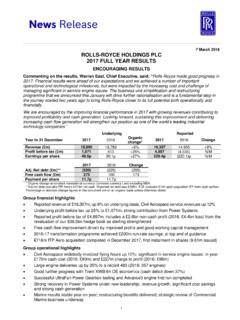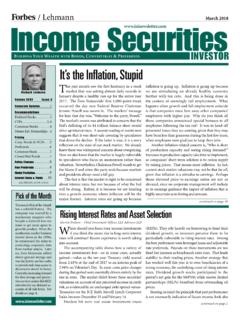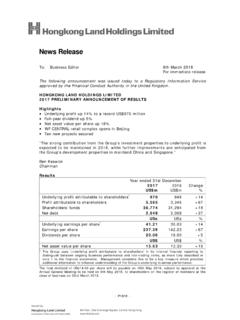Transcription of Employment Outlook 2017 - OECD.org
1 OECD Employment Outlook 2017 OECD 2017 OECD Employment Outlook publication page How does Sweden compare? Employment Outlook 2017 June 2017 The 2017 edition of the OECD Employment Outlook provides an international assessment of recent labour market trends and short-term prospects. It also contains chapters on: benchmarking labour market performance based on the new OECD Jobs Strategy scoreboard; labour market resilience in the wake of the global crisis; the role of technological change and globalisation in transforming labour markets; and key country differences in collective bargaining arrangements.
2 DOI: Labour market developments in Sweden Note: OECD weighted average. Source: OECD calculations based on OECD Economic Outlook Database (No. 101), June LABOUR MARKET TRENDS AND PROSPECTS Labour market conditions continue to improve and the OECD average Employment rate finally returned to its pre-crisis rate in the first quarter of 2017 , nearly ten years after the global financial crisis erupted. The OECD-average unemployment rate continues its slow descent, but remains slightly above its pre-crisis level because Employment has not increased enough to fully offset a rising trend in participation rates.
3 The unemployment rate is projected to fall back to its pre-crisis level in late 2018 or early 2019. The recovery remains very uneven across countries and different groups within the workforce. Unemployment has fallen in Sweden but slower than on average across OECD countries. At in April, unemployment is slightly above its pre-crisis level in 2007. However, Employment in Sweden, as a share of the population aged 15-74, has returned to its pre-crisis level. At ( ) in Q4 2016, it remains well above the OECD average (61%).
4 OECD projections for Sweden suggest that Employment will continue to rise above the OECD level through to the end of 2018. The unemployment rate, though decreasing, is projected to remain above the OECD average and, at the end of 2018, it may still be slightly above its pre-crisis level. In the face of an increasingly digitalised economy, Sweden along with Finland, Japan and Denmark is one of the top four countries in terms of ICT skills of young people. The share of young people with higher ICT competencies is more than twice as high as in the bottom four countries (Lithuania, Chile, Greece and Turkey).
5 This bodes well for Sweden to reap the benefits of further technological progress, which will sustain economic growth. t rate Percentage of total labour force Employment rate Percentage of the population aged 15-74 Projections Projections Contacts: Fabio Manca (+33 1 45 24 99 84; or Mark Keese (+33 1 45 24 87 94; Directorate for Employment , Labour and Social Affairs. OECD Employment Outlook publication page OECD Employment Outlook 2017 OECD 2017 Scoreboard of labour market performance for Sweden Note: An upward (downward ) pointing arrow for an indicator means that higher (lower) values reflect better performance.))
6 Earnings quality: Gross hourly earnings in USD adjusted for inequality. Labour market insecurity: Expected monetary loss associated with the risk of becoming unemployed as a share of previous earnings. Job strain: Percentage of workers in jobs characterised by a combination of high job demands and few job resources to meet those demands. Low income rate: Share of working-age persons living with less than 50% of median equivalised household disposable income. Gender labour income gap: Difference between average per capita annual earnings of men and women divided by average per capita earnings of men.
7 Employment gap for disadvantaged groups: Average difference in the Employment rate for prime-age men and the rates for five disadvantaged groups (mothers with children, youth who are not in full-time education or training, workers aged 55-64, non-natives, and persons with disabilities) as a percentage of the Employment rate for prime-age men. Source and definitions: OECD calculations using data for 2015 or latest year available from multiple sources. See OECD Employment Outlook 2017 , Table for further detailsNEW OECD SCOREBOARD SHOWS RELATIVE STRENGTHS AND WEAKNESSES OF THE SWEDISH LABOUR MARKET The 2017 issue of the OECD Employment Outlook presents a comparative scoreboard of labour market performance that provides a rich overview of the strengths and weaknesses of different national labour markets, going well beyond the standard measures of Employment and unemployment rates.
8 These include measures of job quality (pay, Employment security, working environment) and labour market inclusiveness (income equality, gender equality, Employment access for potentially disadvantaged groups). Some countries score well on most or all indicators, implying that there are no hard trade-offs that prevent countries from performing well in all areas. Sweden generally scores above the OECD average and close to the top performers in several areas of the labour market.
9 While the unemployment rate is on par with the OECD average, its Employment rate is above that of most OECD countries. Sweden scores higher than the OECD average also in terms of the quality of its jobs. Earnings quality is above the OECD average while job strain is lower than in most OECD countries. Labour market insecurity is especially low in Sweden, and close to the group of top performers in the OECD. These results signal Sweden as one example where high-quality jobs can coexist with strong Employment rates.
10 Despite renewed difficulties such as the recent large influxes of refugees, Sweden has been able to score above the OECD average also in terms of labour market inclusiveness and in dimensions such as the Employment gap for disadvantaged groups or the low income rate. This latter dimension has, however, worsened significantly in recent years. Sweden is among the top performing OECD labour markets also when it comes to earnings equality between male and female workers.














